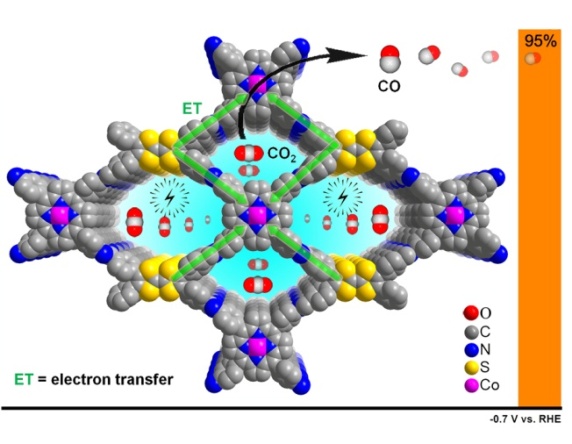
Due to the many possibilities of CO2 reduction products and the accompanying hydrogen evolution reaction (HER), catalytic materials with high efficiency and high selectivity are the key to overcome the disadvantages including low current density, poor selectivity and low conversion efficiency.
Covalent organic framework compounds (COFs), as a new class of porous crystalline catalytic materials, have the advantages of high design ability and active sites distribution at the atomic level. However, the application of most COFs in CO2RR is limited by their poor conductivity and unsatisfactory selectivity.
In a study published in ACS Energy Lett., a research team led by Prof. CAO Rong and Prof. HUANG Yuanbiao from Fujian Institute of Research on the Structure of Matter (FJIRSM) of the Chinese Academy of Sciences has combined tetrathiafulvalene (TTF) with strong electron transfer ability and cobalt porphyrin in a COF (TTF-Por(Co)-COF) with efficient electron transfer ability through an imine condensation reaction.
The researchers found that the electron-rich TTF unit serves as an excellent electron donor with fast electron transfer, while adjacent cobalt porphyrin containing single-site catalytic active center can accept electrons transfer from TTF to greatly improve the CO2 reduction activity.
In electrocatalytic reduction of CO2, the TTF-Por(Co)-COF has a very high CO selectivity, and its Faraday efficiency reaches 95% (-0.7 V vs RHE). And the selectivity and current density are far greater than the COF materials without TTF.
The density functional theory (DFT) calculations by Prof. CHAI’s group at FJIRSM showed that TTF plays an important role in reducing the activation energy barrier and increasing the electron transport rate.
This study provides a new perspective for the design and preparation of framework materials with high electron transfer efficiency, and an important reference for the development of efficient CO2RR catalysts.

Schematic illustration of the research (Image by Prof. CAO’s group)

86-10-68597521 (day)
86-10-68597289 (night)

52 Sanlihe Rd., Xicheng District,
Beijing, China (100864)

